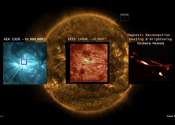Scientists get the lowdown on sun's super-hot atmosphere
A phenomenon first detected in the solar wind may help solve a long-standing mystery about the sun: why the solar atmosphere is millions of degrees hotter than the surface.

A phenomenon first detected in the solar wind may help solve a long-standing mystery about the sun: why the solar atmosphere is millions of degrees hotter than the surface.
Astronomy
Dec 7, 2020
6
314

Cells move constantly throughout our bodies, performing myriad operations critical to tissue development, immune responses and general wellbeing. This bustle is guided by chemical cues long studied by scientists interested ...
Cell & Microbiology
Nov 20, 2020
0
151

Scientists at CU Boulder are developing a satellite about the size of a toaster oven to explore one of the cosmos' most fundamental mysteries: How did radiation from stars punch its way out of the first galaxies to fundamentally ...
Astronomy
Oct 20, 2020
0
98

A Madonna and Child painting with a history almost as enigmatic as the Mona Lisa's smile has been identified as an authentic Raphael canvas by Czech company InsightART, which used a robotic X-ray scanner to investigate the ...
General Physics
Oct 20, 2020
0
30

A team led by the University of Colorado Boulder is pioneering a new solution to the problem of spring cleaning on the moon: Why not zap away the grime using a beam of electrons?
Space Exploration
Aug 31, 2020
1
140

A new study from the Kellogg School of Management at Northwestern University revealed a unique historical pattern that cities follow in order to become strong and innovative economies.
Social Sciences
Aug 24, 2020
0
142

A CIRES-led team has uncovered a critical connection between winds at Earth's equator and atmospheric waves 6,000 miles away at the South Pole. The team has found, for the first time, evidence of a Quasi-Biennial Oscillation ...
Earth Sciences
Aug 17, 2020
1
212

A special type of aurora, draped east-west across the night sky like a glowing pearl necklace, is helping scientists better understand the science of auroras and their powerful drivers out in space. Known as auroral beads, ...
Space Exploration
Aug 14, 2020
3
1574

In February of 2017, the scientific community rejoiced as NASA announced that a nearby star (TRAPPIST-1) had a system of no less than seven rocky planets. Since that time, astronomers have conducted all kinds of follow-up ...
Astronomy
Jul 17, 2020
0
127

Light exerts a certain amount of pressure onto a body: sun sails could thus power space probes in the future. However, when light particles (photons) hit an individual molecule and knock out an electron, the molecule flies ...
General Physics
Jun 15, 2020
2
972